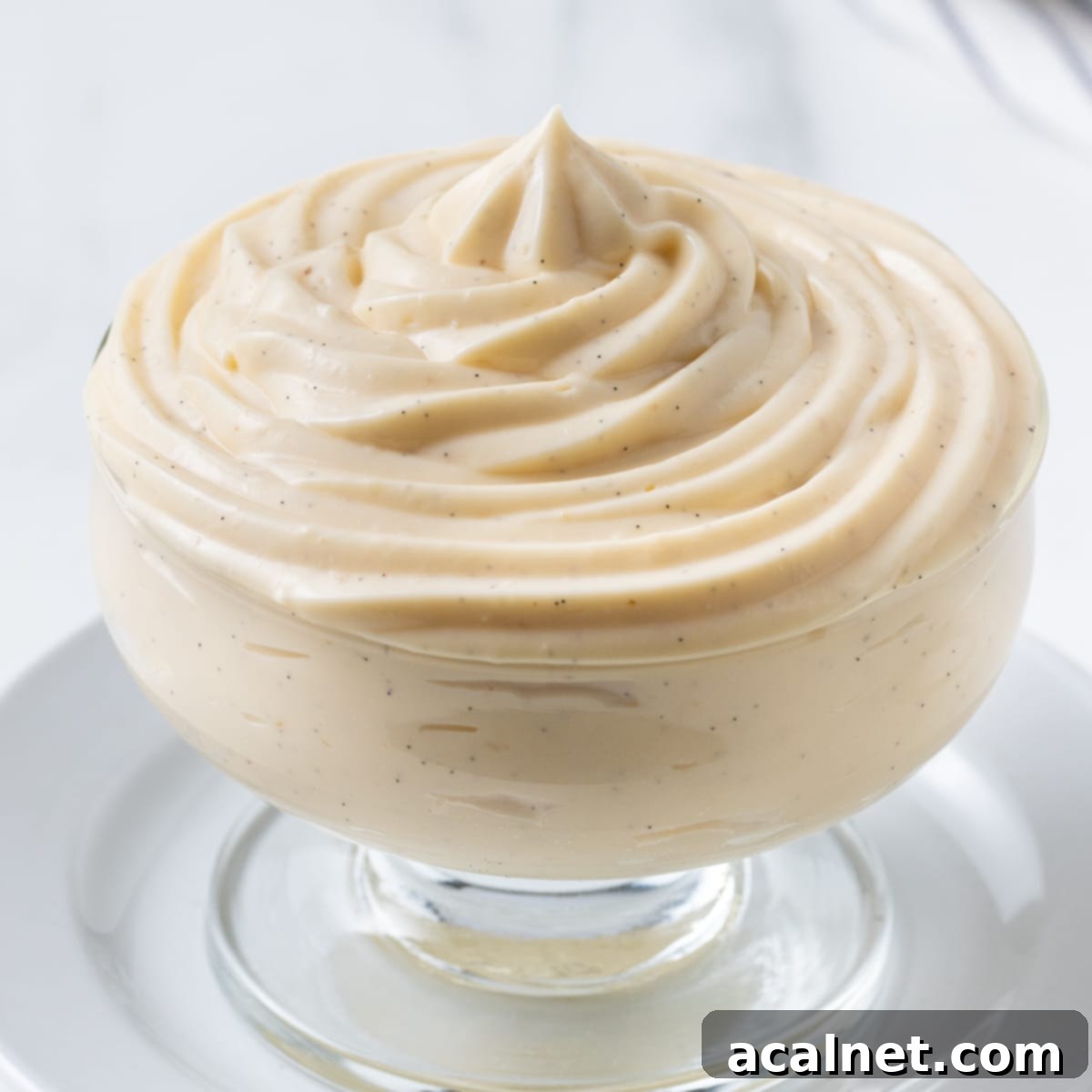Mastering Homemade Vanilla Crème Pâtissière: The Essential French Pastry Cream Recipe
Welcome to the heart of French patisserie! This Vanilla Crème Pâtissière, also known simply as Pastry Cream, is more than just a recipe; it’s a foundational technique that opens up a world of exquisite desserts. Crafted from just five basic ingredients and ready in as little as 15 minutes of active cooking, this rich, creamy, and gloriously smooth custard is an indispensable component in countless French pastries, cakes, and sweet treats. Whether you’re filling delicate éclairs, crafting elegant fruit tarts, or enriching choux pastries, mastering this classic cream is a sweet victory for any home baker.

[feast_advanced_jump_to]
What is Crème Pâtissière? Understanding This French Classic
Crème Pâtissière is a fundamental thick custard or pudding-like cream that serves as a versatile base for an array of French desserts. At its core, it’s a luscious blend of milk, egg yolks, sugar, and a thickening agent, typically flour or cornstarch. This classic French recipe distinguishes itself with its rich texture and incredible adaptability to various flavors, though vanilla remains its most beloved iteration.
The magic happens on the stovetop, where milk is gently heated, then combined with a mixture of whisked egg yolks, sugar, and starch. The starch, alongside the egg yolks, acts as a thickening agent, transforming the liquid milk into a smooth, luxurious cream. While traditional Crème Pâtissière is often infused with the intoxicating aroma of vanilla – ideally from a whole vanilla bean – its neutral base welcomes a multitude of other flavorings. Imagine rich chocolate pastry cream, vibrant lemon, nutty pistachio, or an invigorating coffee variant. The possibilities are truly endless, allowing for creative freedom in your baking endeavors.
This versatile custard is famously the star in many iconic French pastries. It’s the creamy filling in delicate éclairs, the heart of airy choux au craquelin, and the delightful core of classic choux à la crème (cream puffs). Beyond choux, Crème Pâtissière shines as a filling for various tarts, from a simple pâte sucrée crust adorned with fresh fruits, such as these beautiful strawberry tartlets and mini fruit tarts, to baked custard tarts. Its creamy consistency and delicate flavor make it an essential component for elevating even the simplest of desserts into something truly special.
Essential Ingredients for a Perfect Pastry Cream
Crafting a truly exceptional Crème Pâtissière begins with selecting high-quality ingredients. While the list is short, each component plays a crucial role in achieving that signature rich, creamy texture and delightful flavor. Here’s a breakdown of what you’ll need and why:

For precise quantities, please scroll down to the recipe card below.
- Milk: Full Cream Milk (Whole Milk) is undeniably the superior choice here. Its higher fat content contributes significantly to the creamy texture and rich flavor of the pastry cream. Skimmed or low-fat milk is not recommended as it can result in a thinner, less luxurious consistency and a less satisfying taste.
- Egg Yolks: These golden gems are essential for both thickening the cream and imparting a beautiful golden hue, along with a decadent flavor. Using medium-sized eggs, preferably at room temperature, ensures they blend smoothly and temper evenly, preventing any curdling during cooking.
- Sugar: Caster Sugar, or a fine white granulated sugar, is ideal. Its fine granules dissolve quickly, creating a smooth mixture without any gritty texture.
- Cornstarch: This is the primary thickening agent, responsible for giving the cream its characteristic pudding-like consistency. Cornstarch yields a lighter, silkier finish compared to all-purpose flour. It’s crucial to sift cornstarch before use, as it has a tendency to clump, which could lead to a lumpy pastry cream. If cornstarch is unavailable, plain (AP) flour can be used, or another starch like tapioca starch.
- Vanilla: For the most authentic and intense vanilla flavor, a whole Vanilla Bean is highly recommended. Split it lengthwise and scrape out the aromatic seeds to infuse the milk. Vanilla paste is an excellent alternative, offering visible vanilla flecks and robust flavor. While vanilla extract will work in a pinch, it typically provides a less pronounced flavor profile compared to beans or paste.
- Optional: Unsalted Butter: While not strictly necessary, adding a small amount of unsalted butter at the end of cooking can elevate your pastry cream to another level. It provides an extra layer of richness, a silkier mouthfeel, and a lovely sheen. The decision to include butter often depends on the intended use of the cream and personal preference for a richer finish.
Helpful Substitutions
- Milk: For a dairy-free version, various plant-based milks can be used. Soy milk often works very well, providing a good texture, but almond or oat milk can also be experimented with, though they may slightly alter the final flavor and richness.
- Cornstarch: As mentioned, Plain / All-Purpose Flour is a viable substitute, typically used in the same quantity. However, be aware that flour can sometimes result in a slightly heavier or “floury” taste and texture compared to cornstarch. Tapioca starch is another excellent gluten-free alternative that can be used.
How to Make Homemade Vanilla Pastry Cream: A Step-by-Step Guide
Making Crème Pâtissière is a rewarding process that, once mastered, becomes incredibly simple. Follow these steps for a consistently perfect, smooth, and delicious vanilla pastry cream.
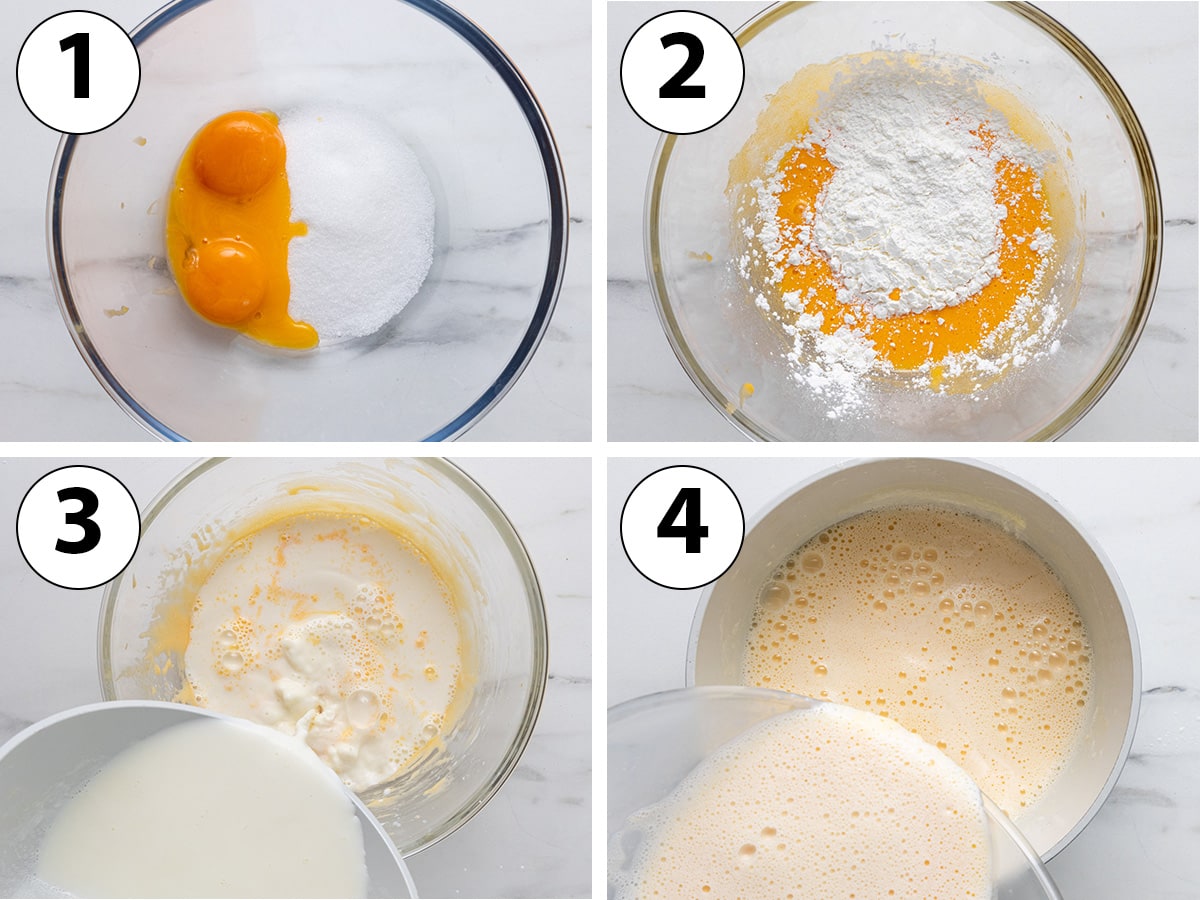
- Infuse the Milk with Vanilla: Pour the milk into a medium-sized saucepan. If using a vanilla bean, slice it lengthwise, scrape out the tiny black seeds, and add both the seeds and the scraped pod to the milk. If using vanilla paste or extract, you can add it now. Place the saucepan over medium-low heat and bring it just to a gentle simmer. Do not boil. Once simmering, remove from heat, cover with a lid, and let the vanilla infuse for at least 20 minutes to develop a deep flavor. If using paste or extract, you can skip the infusion time and proceed immediately to the next step once the milk is warm. Remember to remove the vanilla pod before moving on.
- Prepare the Egg Mixture: In a separate medium-sized, heatproof bowl, whisk together the egg yolks and sugar vigorously for about one minute until the mixture is smooth, pale yellow, and slightly foamy. Then, sift in the cornstarch. Sifting is crucial to prevent lumps. Whisk thoroughly until absolutely no lumps remain, creating a thick, smooth paste.
- Temper the Eggs: This is a critical step to prevent the egg yolks from scrambling. While continuously whisking the egg yolk mixture, slowly pour about a third of the warm, infused milk into the bowl. Whisk well until fully combined. This gradual addition of warm liquid slowly raises the temperature of the egg yolks, preparing them for the hotter liquid without cooking them too rapidly.
- Combine and Cook: Pour the entire tempered egg and milk mixture back into the saucepan. Place it back on the stove over low heat. This low heat is essential to ensure even cooking and prevent scorching or curdling.
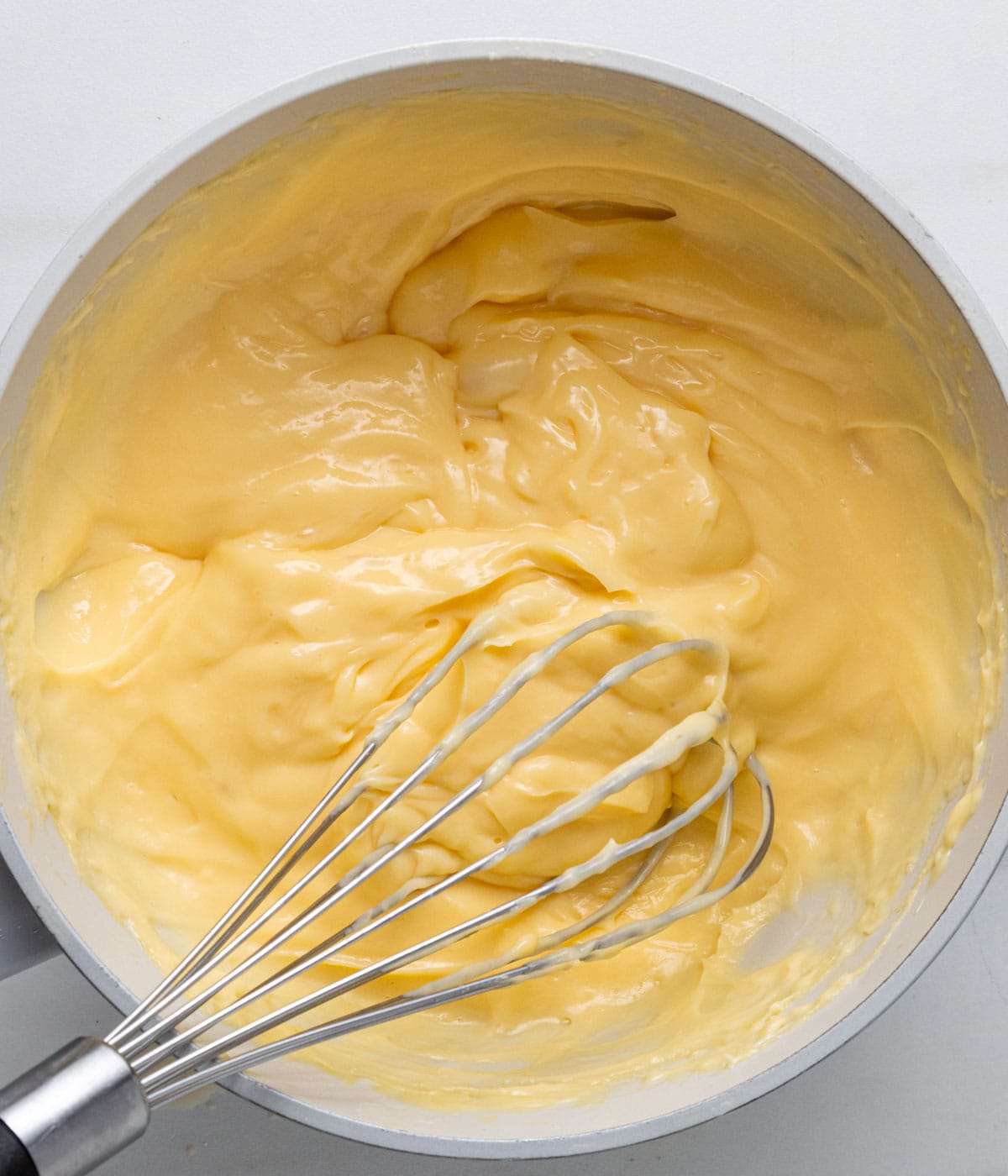
- Whisk Until Thickened: Continuously whisk the mixture in the saucepan for about 5 to 8 minutes. Pay special attention to the bottom and corners of the pan, as the cream tends to thicken fastest there. The cream will gradually thicken into a rich custard. Once you observe large bubbles beginning to puff on the surface, continue to vigorously whisk for another 30 seconds to one minute. This final burst of whisking ensures the starch is fully cooked and activated, yielding a stable cream. Immediately remove the saucepan from the heat.
- Check Temperature for Perfection: For a truly perfect Crème Pâtissière, rely on a kitchen thermometer. The cream is fully cooked and safe to consume once it reaches a temperature between 82°C and 84°C (180°F to 183°F). Cooking above this range risks overcooking the eggs, leading to a curdled or grainy texture.
- Optional: Strain and Add Butter: For an exceptionally smooth cream, you can pour the cooked pastry cream through a fine-mesh sieve immediately after removing it from the heat. This will catch any potential tiny lumps. If you’re adding butter for extra richness, mix it in a small cube at a time into the warm pastry cream, whisking until each piece is fully incorporated and the cream is smooth and glossy.
- Chill Properly: Transfer the warm pastry cream into a shallow baking pan or a clean, wide bowl. This helps it cool down much faster and more evenly than if it were in a deep container. Crucially, cover the surface of the cream directly with plastic wrap, pressing it down so it touches the entire surface. This prevents a skin from forming, which can be unpleasantly rubbery. Refrigerate for at least 2 hours, or until completely chilled and set.
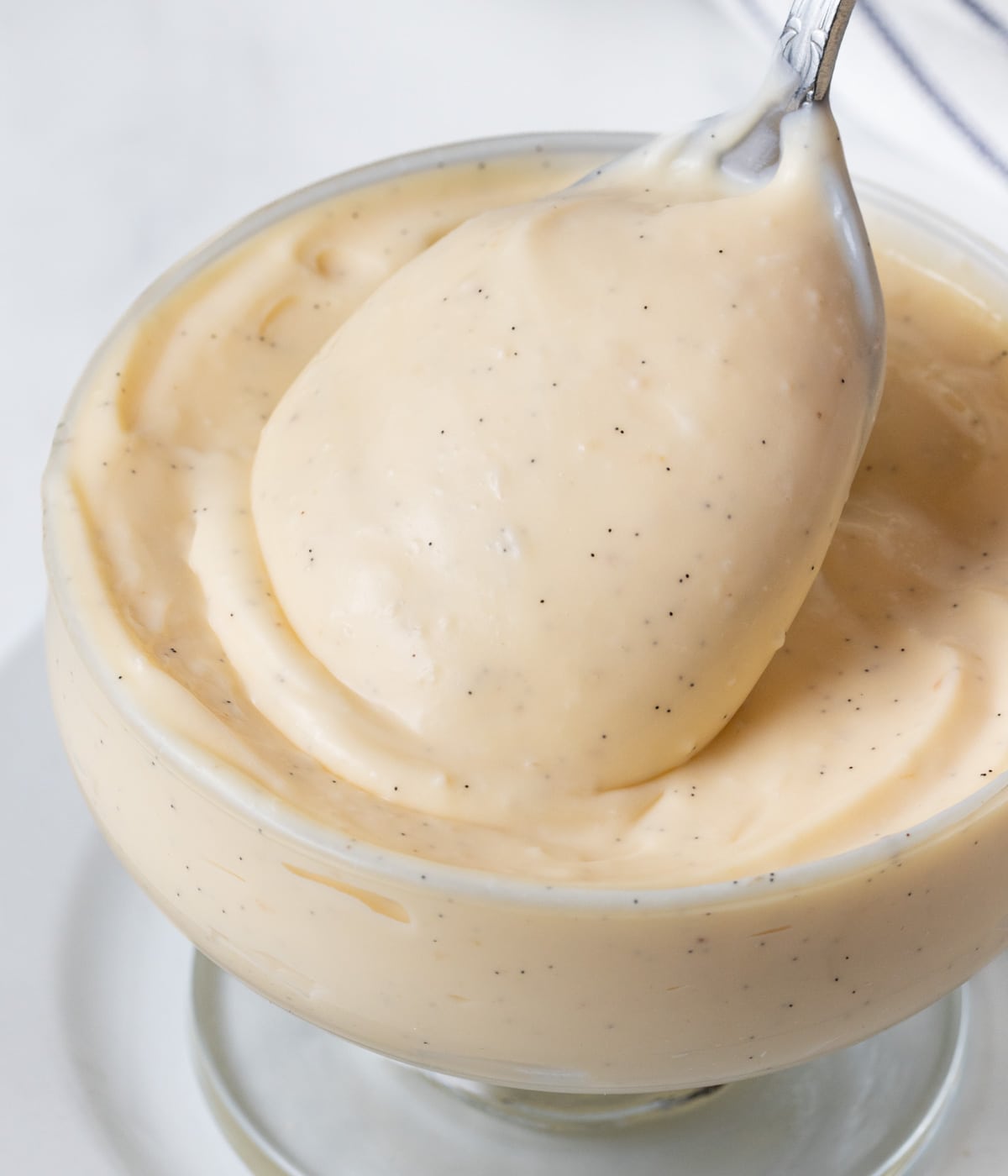
Expert Tips for Making the Perfect Crème Pâtissière
While Crème Pâtissière is a relatively simple recipe, a few key techniques and considerations can elevate your results from good to absolutely perfect. Keep these expert tips in mind for consistently smooth, lump-free, and deliciously rich pastry cream every time:
- Whisk Eggs and Sugar Immediately: As soon as the egg yolks and sugar are combined in the bowl, start whisking them together without delay. If left to sit, the sugar can “cure” or “cook” the egg yolks, creating small, hard lumps that are difficult to remove and can lead to a grainy texture.
- Ensure Lumpy-Free Cornstarch: Cornstarch is notorious for clumping in the package. Always sift it before adding it to your egg and sugar mixture. This simple step is a primary defense against lumps in your finished cream. Whisk it thoroughly with the yolks and sugar until the mixture is perfectly smooth before incorporating any milk.
- Temper Your Ingredients Properly: Tempering is paramount for a smooth custard. Begin with room temperature egg yolks, as they combine more easily and are less prone to shocking when hot liquid is introduced. Pour the warm milk into the egg mixture slowly, in a thin stream, while continuously whisking. This gradual temperature increase prevents the eggs from scrambling.
- Constant Whisking is Key During Cooking: Once the mixture is back on the stove, never stop whisking! Use a sturdy whisk and make sure it reaches every part of the pan – especially the bottom and the edges. These areas heat up and thicken first, and neglecting them can lead to scorching or lumps.
- Always Cook on Low Heat: Patience is a virtue when making pastry cream. Using low heat, even if it extends the cooking time slightly, is crucial for preventing the eggs from curdling and ensuring an evenly cooked, velvety smooth cream. High heat is the enemy of creamy custards.
- Trust Your Thermometer, Not Just Your Eyes: While visual cues are helpful, the most accurate way to know your Crème Pâtissière is perfectly cooked is by temperature. A kitchen thermometer should read between 82°C and 84°C (180°F to 183°F). This temperature range ensures the starch and eggs are fully cooked for stability and food safety, without overcooking the eggs and causing curdling.
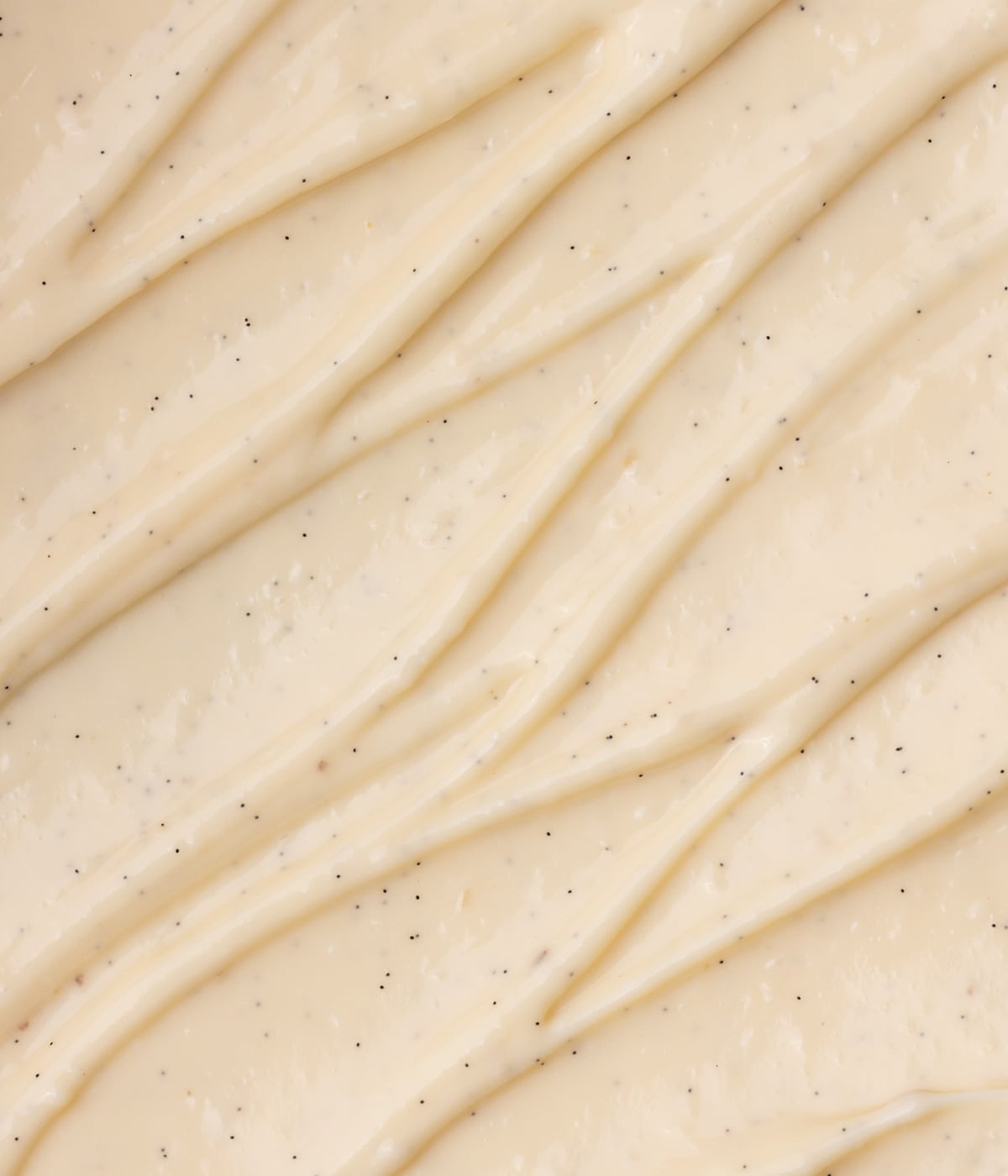
Troubleshooting Common Crème Pâtissière Issues
Even experienced bakers can sometimes encounter challenges with Crème Pâtissière. Don’t worry if your cream doesn’t turn out perfectly on the first try! Most issues revolve around consistency or texture, and thankfully, they are often easily fixable. Remember, the “ideal” consistency can also depend on how you plan to use it.
- The cream is too thick: If your pastry cream is denser than desired, don’t despair. Gently reheat it in a saucepan over very low heat. Away from the direct heat, gradually whisk in a splash of additional milk (or even a little cream for extra richness) until it reaches your preferred consistency. Return to the stove briefly if needed to ensure it’s still warm and smooth.
- The cream is too liquid: If your cream seems too thin, it likely needs more thickening. In a separate small bowl, whisk together a tablespoon of cornstarch with a tiny amount of milk (just enough to create a smooth slurry). Remove the main saucepan from the heat, whisk the cornstarch slurry into the runny cream until fully combined, then return it to low heat. Continue to whisk constantly until the cream thickens. You can repeat this process with another small amount of slurry if necessary.
Note: Crème Pâtissière always thickens considerably as it cools in the fridge. Before making adjustments, allow your cream to cool completely for at least 2 hours. If it’s still too liquid after chilling, then proceed with adding more starch and gently reheating.
- There are lumps in the cream: Lumps usually indicate that the ingredients weren’t properly tempered, or the cream was cooked over too high a heat, causing the eggs to curdle or the starch to clump. First, try whisking the cream very vigorously to break down any small lumps. If the lumps persist and are fine, passing the cream through a fine-mesh sieve can help. For more stubborn lumps, an immersion blender used briefly on the lowest speed can effectively smooth out the cream.
Important: Be cautious not to over-blend the cream with an immersion blender, as this can break down its structure and turn it into a thin, soupy consistency. Blend only for a few seconds until smooth.
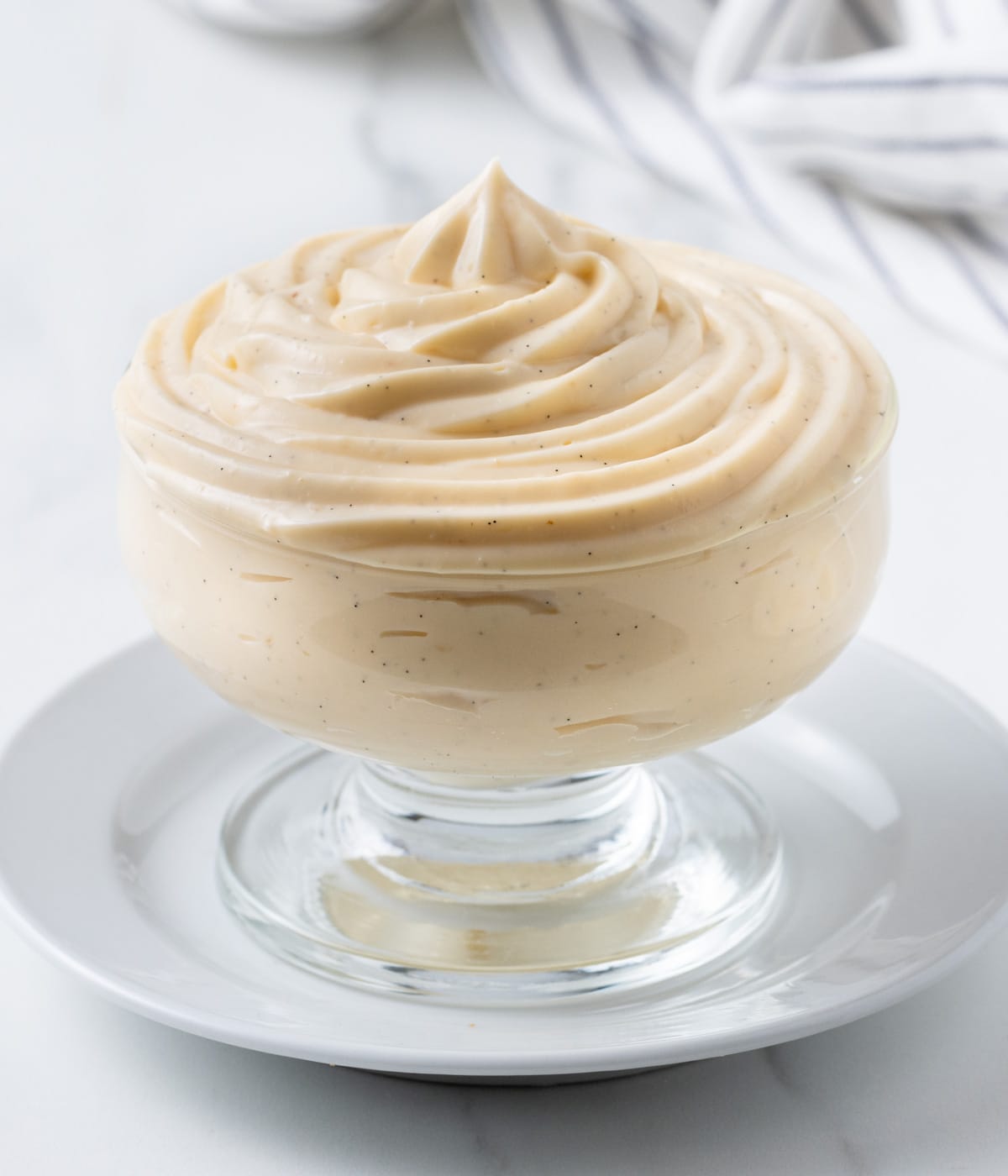
Crème Pâtissière: Frequently Asked Questions
While both are classic French custard bases made on the stovetop with similar ingredients, their key distinctions lie in their composition and consistency:
- Thickening Agent: Crème Pâtissière is thickened with both egg yolks and a starch (flour or cornstarch), giving it a thick, spoonable, pudding-like consistency. Crème Anglaise, on the other hand, relies solely on egg yolks for thickening and contains no added starch, resulting in a much thinner, pourable sauce-like consistency.
- Dairy Base: Crème Pâtissière typically uses milk (or a combination of milk and cream), while Crème Anglaise is more traditionally made with just cream, contributing to its rich, smooth mouthfeel.
- Usage: Crème Pâtissière is primarily a filling for pastries and cakes, whereas Crème Anglaise is often served as a pouring sauce alongside desserts.
A valuable tip often taught in pastry schools is a simple rule for cooking time: for every 1 liter of milk, the cream should cook for 1 minute *after* it reaches its first boil and thickens. This means if you’re making a smaller batch, say with 500ml (approximately 2 cups) of milk as in this recipe, you would cook it for about 30 seconds after it begins to bubble and thicken. The cooking time commences once all ingredients are combined in the pot and you observe the first large bubble appear on the surface of the cream. Adhering to this guideline ensures not only the perfect custard consistency but also thoroughly cooks the egg yolks for safety.
Proper cooling is essential for the texture and quality of your Crème Pâtissière. Once cooked, speed is key to prevent bacterial growth and achieve the best consistency. Here’s how:
- Shallow Pan: Immediately transfer the hot cream into a large, shallow pan (like a brownie pan or a wide baking dish). Spreading the cream thinly allows it to cool much more quickly and uniformly compared to a deep bowl.
- Plastic Wrap Contact: Cover the surface of the cream directly with plastic wrap, ensuring the film touches every part of the cream. This crucial step prevents the formation of an unappealing, rubbery “skin” on the surface, which happens when the cream is exposed to air during cooling.
- Refrigeration: Place the covered pan in the refrigerator and allow it to cool completely for at least 2 hours, or until thoroughly chilled and firm. Once fully cooled, the cream will naturally become much thicker than it was warm. Before using it to fill your desserts, give it a good whisk to loosen it up and restore its smooth, velvety texture.
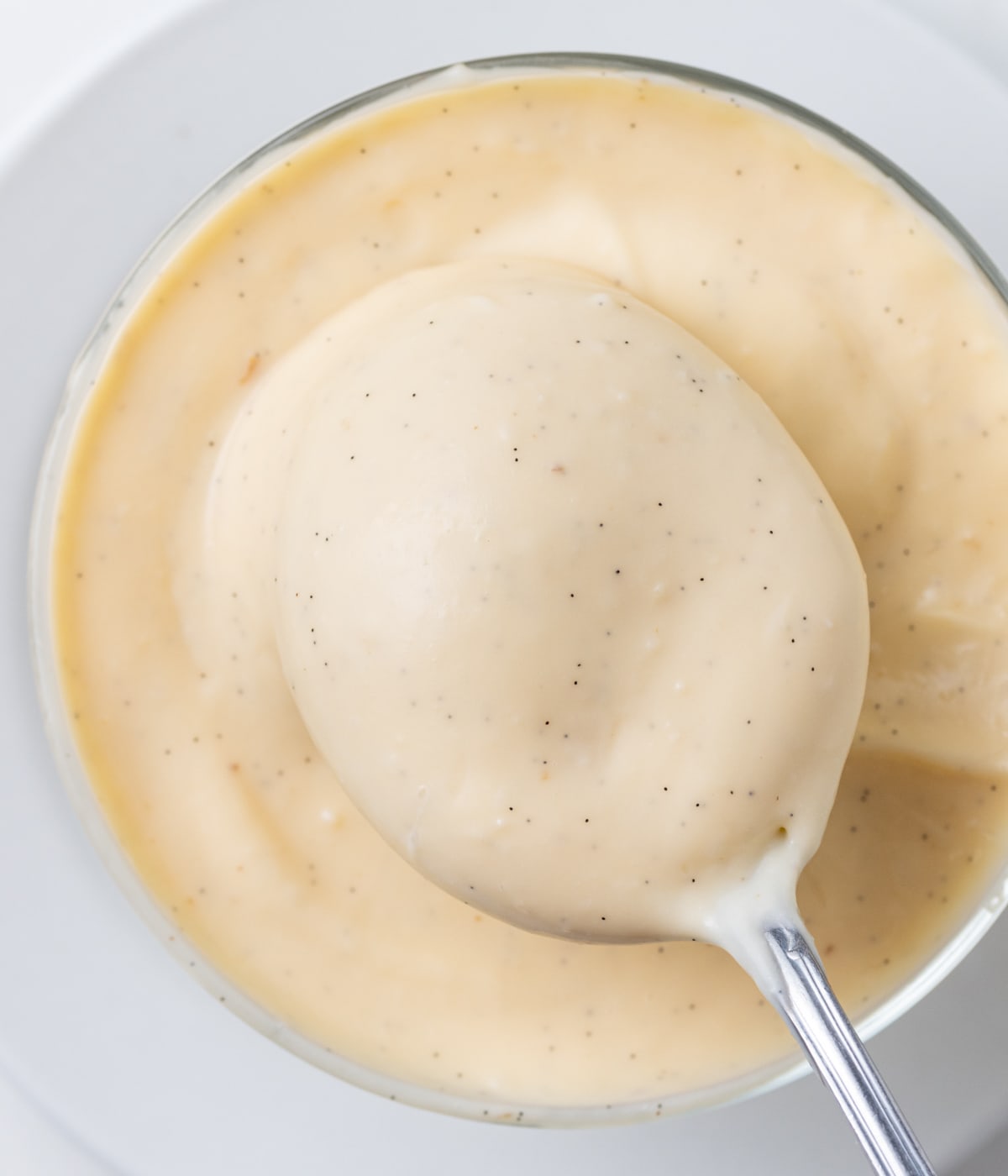
Unleash Your Creativity: How to Use Vanilla Pastry Cream
The beauty of Crème Pâtissière lies in its incredible versatility. Once you’ve mastered this basic vanilla version, a world of dessert possibilities opens up. Its rich, smooth texture and delicate flavor make it perfect for a vast array of applications, both as a standalone treat and as a building block for more complex creations.
Classic French Applications:
- Choux Pastries: The most iconic use! Fill delicate éclairs, cream puffs (choux à la crème), or crispy choux au craquelin.
- Tarts: A classic filling for fruit tarts, like these Strawberry Tartlets with Pastry Cream Filling or Mini Fruit Tarts. It can be baked inside a tart shell for a delicious Plum and Vanilla Custard Tart or a Rhubarb and Custard Tart.
- Mille-Feuille (Napoleon): Layer it between crisp puff pastry sheets for this elegant, multi-layered dessert.
- Pies: Use it as a luscious filling for cream pies.
Beyond the Classics:
- Cake Filling: Spread it between layers of sponge cake for a moist and flavorful filling.
- Trifles and Parfaits: Layer it with fruit, cake, and whipped cream for stunning individual desserts.
- Vanilla Mousse: Crème Pâtissière is the perfect base for lighter creations like these Vanilla Mousse Cups.
- Pancakes or Crêpes: A delightful filling for breakfast or dessert pancakes and crêpes.
Building Blocks for Other French Creams:
Vanilla Crème Pâtissière serves as the foundational base for several other popular and more complex French pastry creams, each offering a unique texture and richness:
- Crème Diplomate: This is pastry cream lightened with whipped cream and often stabilized with gelatine, making it airy and stable. It’s famously used in desserts like the Fraisier Cake.
- Mousseline Cream: Pastry cream enriched by whisking in a significant amount of butter, resulting in an incredibly smooth, rich, and stable cream that holds its shape beautifully.
- Crème Légère (Light Cream): A simpler version of Crème Diplomate, this is pastry cream folded with whipped cream, offering a lighter, less dense alternative.
- Crème Chiboust: A sophisticated cream made by folding Italian meringue into warm Crème Pâtissière, resulting in a light, airy, and marshmallow-like texture.
Flavor Variations:
Don’t stop at vanilla! This base cream is incredibly adaptable to other flavors:
- Fruit & Citrus: Infuse with lemon or orange zest, or fold in fruit purées for vibrant flavors.
- Coffee: Dissolve instant coffee powder or strong espresso into the warm milk. Try these Coffee Choux Buns.
- Nuts: Incorporate nut pastes like pistachio paste or hazelnut praline paste for a rich, nutty flavor.
- Chocolate: Whisk melted chocolate into the warm cream for a decadent chocolate pastry cream.
Storing & Freezing Your Crème Pâtissière
Proper storage is crucial to maintain the quality and safety of your homemade pastry cream. As it’s a dairy and egg-based product, it’s perishable and requires careful handling.
- How long does Pastry Cream last: Crème Pâtissière must always be stored in the refrigerator. When kept in an airtight container and properly covered with plastic wrap directly touching its surface (to prevent a skin from forming), it will remain fresh and delicious for up to 3 days. Any longer, and its quality and safety may diminish.
- Can I freeze Custard? It is generally not recommended to freeze Crème Pâtissière. The freezing and thawing process tends to break down the starch and egg emulsion, causing the cream to lose its smooth, thick consistency and become watery, grainy, or soggy. For best results, always make pastry cream fresh or within the recommended refrigeration period.
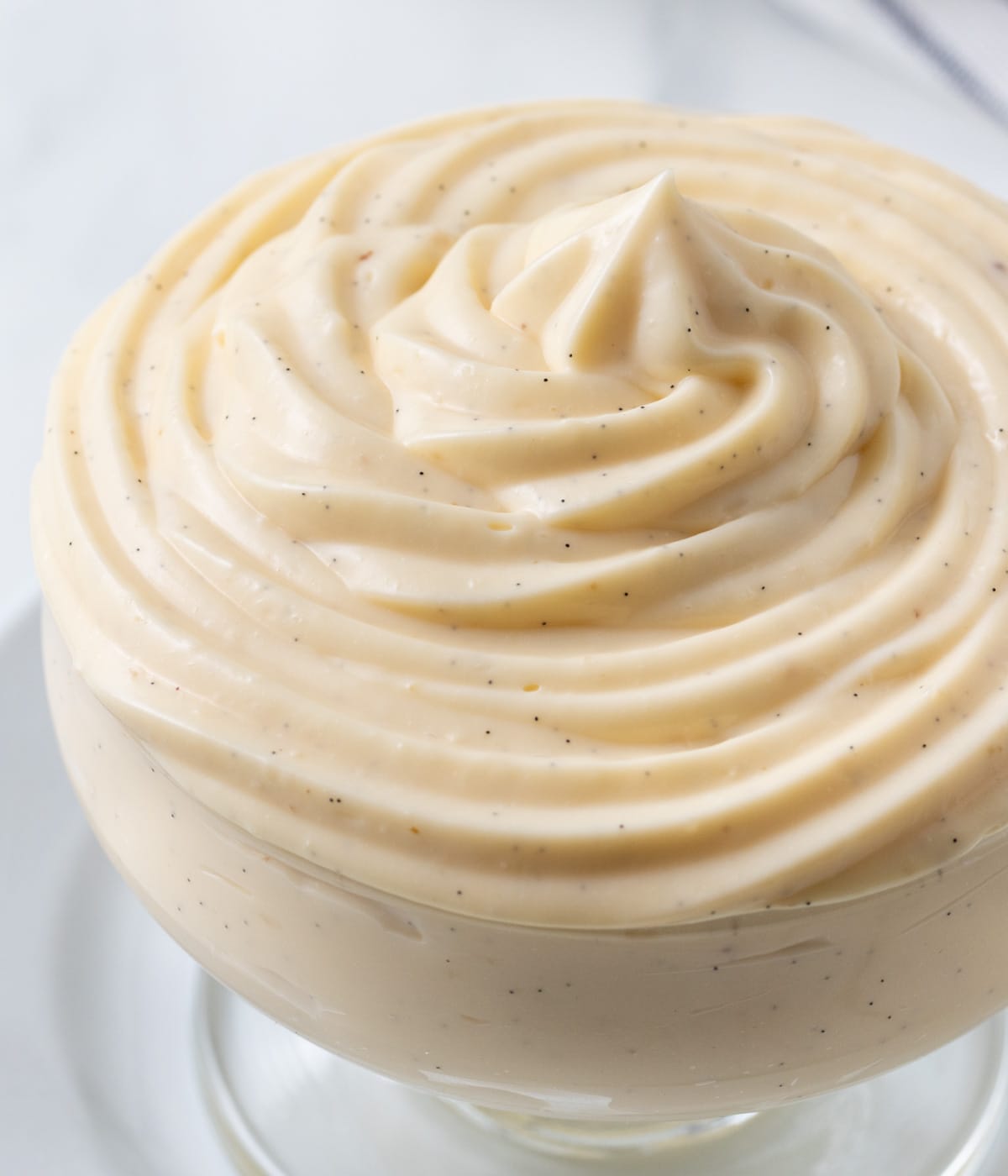
Discover More Classic French Recipes
If you’ve enjoyed mastering Crème Pâtissière, explore these other essential French pastry components and techniques to further hone your baking skills:
- Crème Chantilly (Chantilly Cream)
- Chocolate Cremeux
- Bavarian Cream
- Namelaka
- Crème Anglaise
- Homemade Hazelnut Praline Paste
- Mousseline Cream
- Stabilised Mascarpone Whipped Cream
Made this recipe?
We’d love to hear from you! Leave a comment below and share your delicious creations on Instagram by tagging us @a.baking.journey!
Recipe Card

Crème Pâtissière (Vanilla Pastry Cream)
Print Recipe
Ingredients
- 500 ml Full Cream / Whole Milk
- 1 Vanilla Bean, or 1 1/2 teaspoon Vanilla Paste
- 4 large Egg Yolks, at room temperature (approx 80 grams)
- 45 gr Caster Sugar, or fine white granulated sugar
- 40 gr Cornstarch, or Plain / A-P Flour
- 30 gr Unsalted Butter (optional), cubed, at room temperature
Instructions
- Place the Milk in a small saucepan. Slice the vanilla bean in half, scrap the seeds then place both the seeds and the bean in the milk. Turn on low heat and bring to a simmer. Turn off the heat, cover the sasucepan with a lid and leave to infuse for 15 to 20 minutes. If using Vanilla Paste or extract, you do not need to let it infuse in the milk.
- In a seperate heat-proof bowl, whisk the Egg Yolks and Sugar until foamy. Add the sifted Cornstarch and whisk until smooth.
- Carefully pour the warm milk over the Yolk/Sugar mixture while continuously whisking (see note 1). When all smooth, transfer the whole mixture back into the saucepan over the stove and turn on low heat
- Keep whisking on low heat until the cream starts to thicken – about 5 to 8 minutes (note 2). When you see the first bubble appear on top of the cream, keep whisking for 30 seconds then directly remove from the heat (note 3).
- To precisely cook the pastry cream, use a kitchen thermometer. The custard is cooked once it reaches 82 to 84 degrees Celsius (180 to 183 degrees Fahrenheit).
- If using the Butter, add it into the warm pastry cream a little bit at a time. Mix well and continue to add until all fully incorporated and smooth.
- Transfer the Pastry Cream into a large shallow pan or container (note 4) and cover with plastic wrap touching the surface of the cream (note 5).
- Place in the fridge and leave to cool down set for at least two hour – or until cool and thickened.
- Keep in the frigde for up to 3 days, until ready to be used. Before using, whisk the cream to loosen it.
Video
Would you like to save this recipe?
We’ll email this post to you, so you can come back to it later!
Notes
- This step, known as tempering, is crucial to gradually bring the egg yolks up to temperature, preventing them from scrambling or burning once placed on the stove.
- Always cook Crème Pâtissière over low heat. While it takes a little longer to thicken, it’s the most reliable way to achieve a silky-smooth texture without scorching the cream or curdling the eggs.
- The cooking time is proportional to the amount of milk. A general rule from pastry schools is 1 minute of cooking for every 1 liter of milk once it reaches a boil. For 500ml (half a liter), cook for about 30 seconds after the first big bubbles appear.
- Transferring the warm cream to a shallow pan helps it cool down rapidly and evenly, which is important for both texture and food safety.
- Covering the cream’s surface directly with plastic wrap prevents a thick, rubbery skin from forming as it cools, ensuring a perfectly smooth finish.
Nutrition (per serving)
